Episode 5
Public School/Museum Collaboration in Baltimore (with Beth Maloney and Anne Rosenthal)
Show Sponsor
Landslide Creative provides custom website design and development for museums who want to increase their engagement and connect with their visitors, donors, and volunteers. Stop fighting with your website and focus on growing your impact. Visit LandslideCreative.com to learn more.
Show Notes
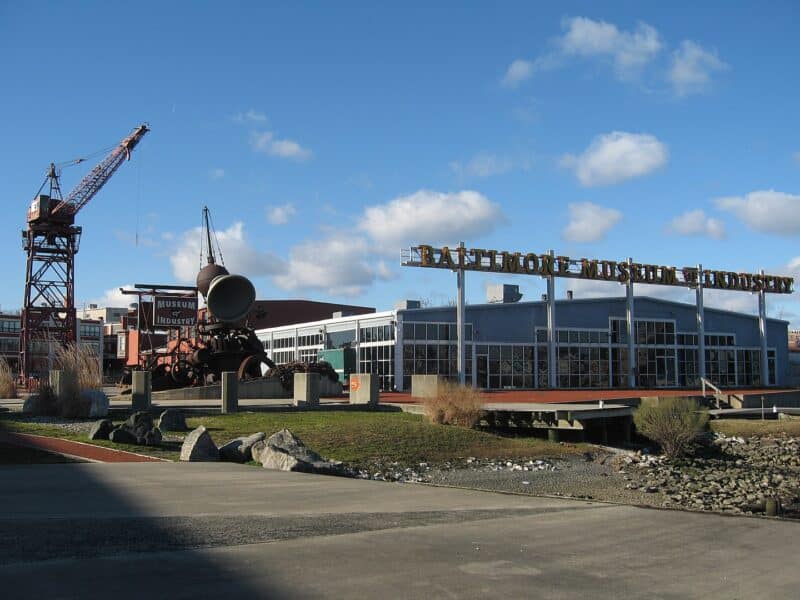
About the Episode
Baltimore City Public Schools wanted to honor their food service workers, who plate up 88,000 free school meals a day and fed their community daily through pandemic closures. The Baltimore Museum of Industry wanted a project to foster social resilience. They collaborated to create Food for Thought, an exhibition featuring food service workers’ portraits and voices alongside powerful facts about school nutrition. I spoke to BCPS’ Anne Rosenthal and BMI’s Beth Maloney about this partnership and what museums can learn from it.
About our Guest
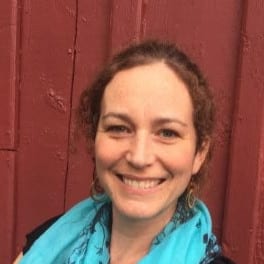
Beth Maloney is the Director of Interpretation at the Baltimore Industry and an independent museum consultant. She previously worked at the Oakland Museum of California, the Lower East Side Tenement Museum, Museum of the City of New York, and California Academy of Sciences. Beth holds an MSEd in Museum Education from the Bank Street Graduate School of Education.
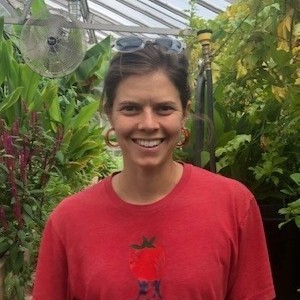
Anne Rosenthal is a farm-to-school specialist with the Food and Nutrition Services Department of Baltimore City Public Schools. Anne holds a Master’s of Public Health degree from the Johns Hopkins Bloomberg School of Public Health and a Bachelor Degree in Environmental Studies from Wesleyan University. Prior to coming to BCPS and Great Kids farm, Anne conducted research on global health and sustainability in New York and Belgium; supported community health workers in Mexico; and taught English to elementary schoolers in Spain.
Links
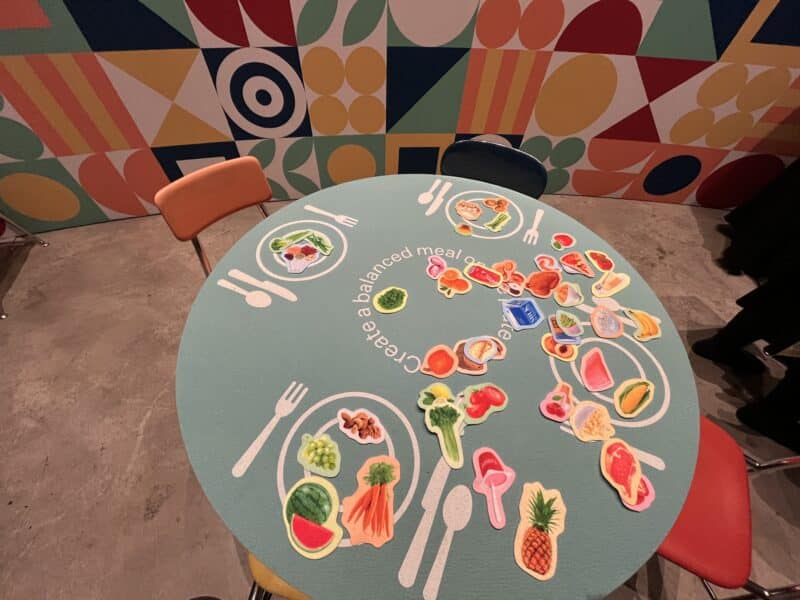
Food for Thought Exhibition – Information and Online Version
Sparrows Point: An American Steel Story (Baltimore Museum of Industry’s Podcast)
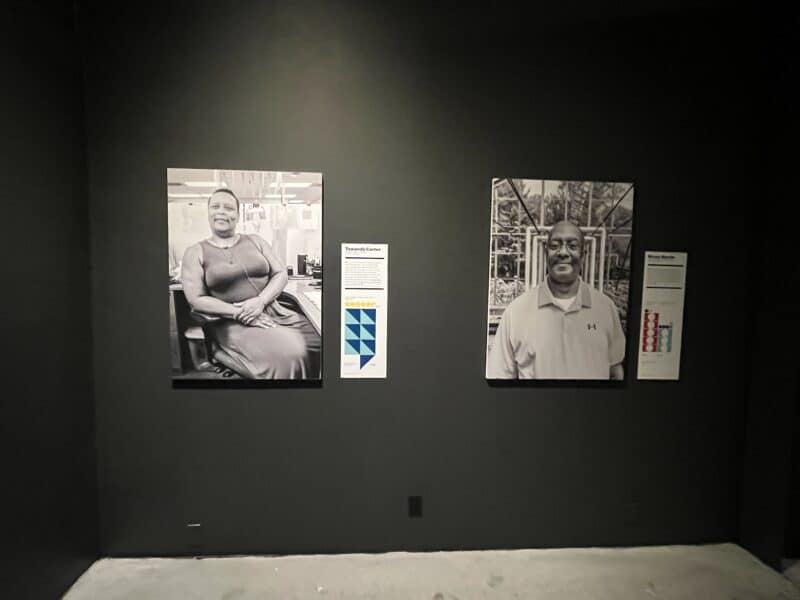
“Food for Thought: Spotlighting Baltimore’s Frontline Food Service Workers” (Journal of Museum Education, Aug 2022)
“Collaborations: Notes from the Field” (Museum Education Round Table, Sep 2022)
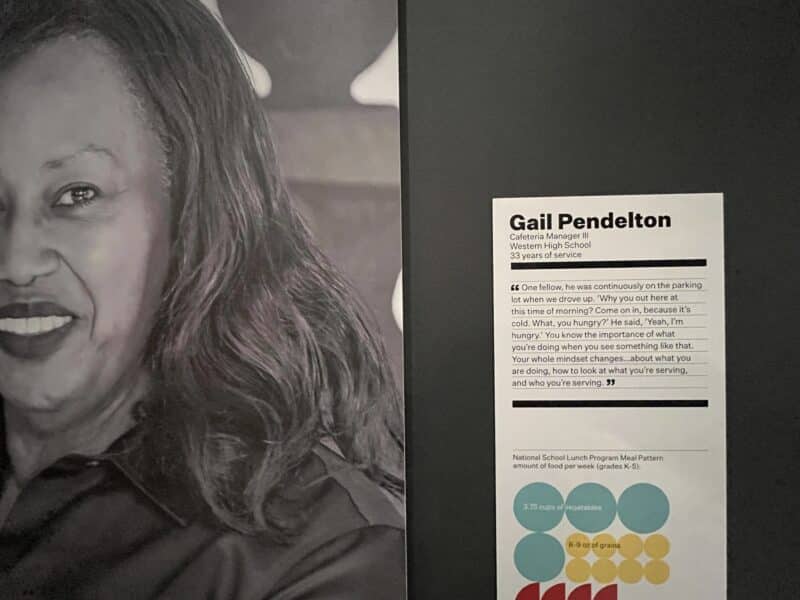
“Food for Thought: Praise for Food Service Workers!” (WYPR, Oct 2022)
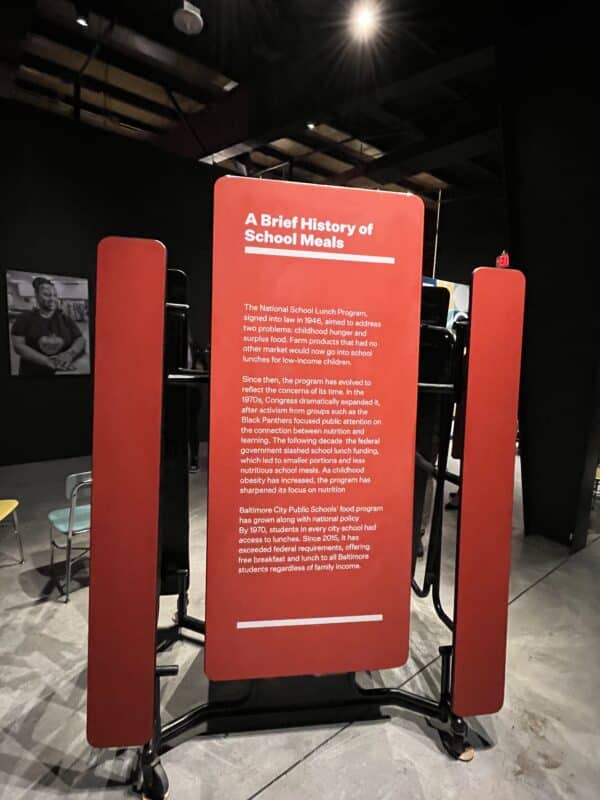
“Bread, Pastrami and Cocktails: Museum Shows Focus on Food” (New York Times, Oct 2022)
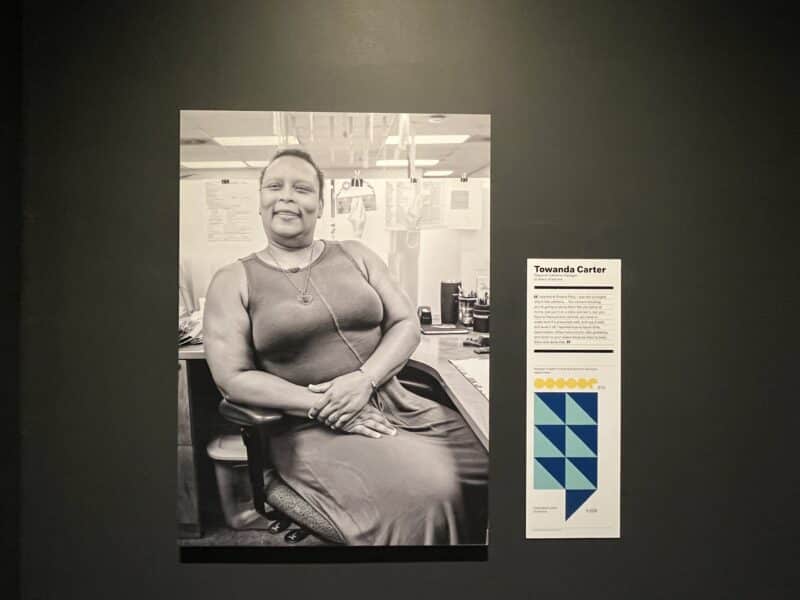
“New Exhibit Honors Food and Nutrition Service Workers in Baltimore City Schools” (Baltimore Magazine, October 2022)
Transcript
Hannah Hethmon (Narration): Welcome back to We the Museum: a podcast for museum workers who want to form a more perfect institution.
I’m your host, Hannah Hethmon, Owner and Executive Producer at Better Lemon Creative Audio, where I make podcasts for museums, history organizations, and other cultural nonprofits.
I live in Maryland, not too far from the city of Baltimore. Earlier this spring, one of my museum friends invited me to the opening of a new exhibition at the Baltimore Museum of Industry. The goal of this exhibition was to highlight the dedicated service of public school food service workers in the city.
Baltimore City Public Schools’ Food and Nutrition Services employees prepare and distribute more than 88,000 free meals to students every day. Even when school buildings closed during the COVID-19 pandemic, these essential workers continued to feed city students and their families.
The Food for Thought exhibition showcases some of these dedicated individuals and the work they do. It’s the end-result of a multi-year collaboration between the museum and Baltimore City Public Schools.
I was blown away by the impact of this small exhibit and what I learned. I was also really struck by this partnership, and so I asked Beth Maloney from the museum and Anne Rosenthal from Food and Nutrition Services to chat with me about the process and what the museum field can learn from this relationship.
Before we jump into that conversation, I want to shout out our show sponsor, Landslide Creative. This podcast would not be happening without their support. Landslide Creative provides custom website design and development for museums who want to increase their engagement and connect with their visitors, donors and volunteers. With a custom website designed for the unique needs of your museum you can stop fighting with your website and focus on growing your impact. Head over to LandslideCreative.com to learn more.
Alright, let’s talk public school/ museum collaborations:
Beth: My name is Beth Maloney. I currently work as the director of Interpretation at the Baltimore Museum of Industry, which means that I’m working on all of the things that sort of are public facing at our organization, from school programs to community public programs to exhibition development collaborations, partnerships, and I also get a chance to do some sort of organizational strategic planning work.
Anne: My name is Anne Rosenthal. I’m a farm to school specialist with the Food and Nutrition Services Department of Baltimore City Public Schools. So part of my work revolves around creating hands-on opportunities for students to connect with their food system and nature. And part of my work involves coordinating special projects that honor the great work of our staff, promote our meal programs, and help get healthy foods into our cafeterias.
Hannah: Great. All right. So let’s start off with the exhibition itself, so our listeners can kind of get that visual sense of what the physical final product of this collaboration is. So I was thinking, Beth, maybe you could describe, you know, what are people seeing when they come in and visit? How’s it set up? What are the main components? And then we’ll turn it over to Anne to talk about the subject matter, the people, the stats, the work of the Food and Nutrition Department.
Beth: Great. I’ll start with sort of a description of the exhibition here at the Baltimore Museum of Industry. It’s in one of our large temporary gallery spaces. And the exhibition features sort of three main elements—maybe four main elements. The first element being really gorgeous professional portraits of food and nutrition service workers that are sort of oversized. They’re black and white portraits, and they’re sort of theatrically lit by this new lighting system in the gallery. So that’s component number one.
The second component which is a huge and really strong aspect of the show is audio interviews. We’re calling them audio snapshots of each of the featured exhibition honorees. Each of the featured workers these are 60 to 92nd sort of audio clips of these folks talking in their own words and their own voices about their job, about what they, what they do in the city school system.
And then the third component are these infographics. So data that kind of help provide a context to some of the stories that you’re hearing in the space. And these three elements are sort of paired. They’re, they’re paired throughout the space. And then there’s also an interactive area of the gallery where you can do things that are a bit more hands-on. We have different stations where folks can, you know, write something or play a little game about that helps them sort of understand nutritious, like making nutritious choices, making healthy choices. There’s an opportunity to do some drawing. And in that area, we also feature some student artwork. So as part of this work students in Baltimore City Public Schools we’re given the opportunity to create work along a theme. And four of those pieces are also featured in the exhibition.
Hannah: And before I turn it over to Anne, I’ll say that having been to it, it’s very colorful. One of the main texts for the exhibition is on a school lunch table put up. There’s little school chairs, colorful, everywhere. It really gives you this colorful, maybe elementary school vibe when you walk in, whichis really lovely and kind of sits really nicely against the black and white portraits. So I loved that.
Beth: Hannah, thank you for mentioning that. You know, the exhibition furniture was also an incredible outcome of this collaboration. We Anne helped arranged for us to go to this warehouse where there was a lot of furniture, chairs, tables, things that were no longer in use in the classroom. And so we went as a team with our designer and we selected furniture and then kind of gave it the second life in the exhibition, you know, gave all the chairs new feet put our main, some of our main labels on the surface of a standing table. So it does, yeah, it really does feel good to see all of that furniture in this new setting. And before, before we move on, I also wanna talk about two other components to the exhibition.
There’s a smaller version of the show that’s installed in the offices of Baltimore City Public Schools in their district office in the lobby. And that show is really just the, it focuses mostly on just the portraits. And then there’s also an opportunity for folks to hear the audio and see the portraits online.
Hannah: So then Anne would you tell us about this work that is being featured about the people that are being featured? What are we talking about here? Who’s, Who’s on the walls, and what do they do?
Anne: Yeah, so this was a very exciting process for us too because, from the beginning, the Baltimore Museum of Industry team was extremely open to really co-creating this with the staff that they’d ultimately feature. So from the start, you know, the idea was always generally that we wanted to bring attention to our frontline food service heroes. So the folks who are working every day in our cafeterias or behind the scenes so that our cafeterias function, the district has, just for some context, the district has about 165, school sites where we serve free breakfast and lunch every day. Many schools also offer snacks, supper, and summer meals for free for students. Any student in Baltimore City is offered a free breakfast and lunch. So even if their parents make a billion dollars, they can eat for free at our schools. So we’re lucky to be a district where there’s this kind of blanket free meal coverage.
So during the pandemic our staff continued to serve when lots of other people were getting breaks or working from home. Our staff continued to serve every day. We experimented with lots of different formats. And one outcome of the pandemic was a little bit more appreciation for frontline heroes. Everyone saw the signs out, you know, in front of people’s houses, celebrating nurses, doctors, teachers. And we consider our food service staff a big part of this kind of frontline staff world. So we wanted to bring attention to their work. We also have a lot of staff who’ve worked in the district for decades, so they bring a ton of institutional knowledge and historical context to their work every day, and we wanted to celebrate that as well.
But from the beginning, we didn’t have a very specific idea of what the outcome would look like. So it was amazing to work with Beth and Auni and other members in their team to really figure out how we could kick off a process that would give our staff also ownership in the creative process. No, please go ahead. So in the end, the outcome is really an exhibit that documents and honors the work of specifically nine of our food service staff. These staff have held different roles throughout the district in their tenure. Many of them have worked, I think all of them have worked in a cafeteria line at some point. Many of them are still working, a few are retired. So so yeah, we are excited about the final product that also brings attention to the history of school meals.
Themes that emerged pretty immediately when we started asking our staff what they would want people to know about their work: one major theme was the public health and nutrition aspect. So we always talk about the fact that everyone loves to hate school meals. There’s a lot of stigma, generational stigma around school meals. And we wanted to really shine light on the fact that our menus really have to be nutritional to meet federal guidelines. And if you look at the evolution of school meals, it really started as a public health nutritional intervention. And that continues to be how we see it. So in a city where there’s a lot of food insecurity, high poverty levels, our staff really see themselves as playing a major role in nourishing students so they can be better learners, better classmates better family members. So that was a big theme that emerged.
Hannah (Narration): I’m going to interrupt here to play two of the audio snapshots from the exhibition, which were collected by Aaron Henkin. First, we have Shelia Alston, who served the school district for 35 years.
Shelia Alston [Clip from Exhibition]: My name is Shelia Alston. I am a retired food service employee with Baltimore City. I was with the organization for 35 years. With food and nutrition, we are part of the learning process with the kids, because a child cannot learn if they’re hungry. So we give them the nourishment they need in order for them to function and their brain to function. When students would come in, and they basically would come, and they didn’t like a particular food item or the choices that we had for that day. I would talk to them. And I had one particular one. I would say, “Well, try this, because I really like it, and I didn’t really know this item even existed.” And they would try it, and then once the young lady tried it, she came back and hugged me and said, “Oh, that was really good.” And it really made me feel good to know that I did something to help someone.
Hannah (Narration): And one more…let’s listen to Towanda Carter, who has served city schools for 21 years so far:
Towanda Carter [Clip from exhibition]: My name is Towanda Carter, a regional cafeteria manager for food nutrition, Baltimore City Public Schools. I started at Roland Park, and the great thing about it was, I was the youngest one in the cafeteria, and I had all these [inaudible 00:01:57], beautiful women saying, “Honey, don’t pick up that whole case. Break that case down. You’re going to break your back down. Wear the right shoes, and don’t do this, and slice the meat like that.” And it was just guidance that they gave us, say like, “Put four ounces, and put eight ounces, and cut the pizza this way.” So you come in thinking you’re going to serve them like you serve at home, just put it on a plate and eat it, but you have to have portion control, and you have to make sure it’s presented well, and cup it well, and level it off. And they was just so supportive. And they knew I had to go home to kids. “Take this to the kids and tell the kids that we love them.” It was just such a beautiful experience. And coming in and trying to give them two scoops because this one needs it. “No, baby, just do the portion control. Just give him what we supposed to give them. We don’t want to over…” I was like, “Yes, ma’am. Okay, you right.” “Make sure you be on time. Don’t be late because we’re counting on you.” I was like, “Yes, ma’am. You right.” So I learned how to be on time, dependable, follow instructions, take guidance, and listen to your elders because they’ve been there and done that.
Anne: When we’re talking about all the ways we built out this exhibit, including the, the main exhibit at the museum and then the small satellite installation at central offices we also really wanted to make sure students had a voice in this. So there, we launched a student artwork contest to give students from all grades a chance to respond to different prompts about food related to heritage and food and food insecurity food systems generally. So we right now actually have an exhibit of the winning pieces in our central offices here at the city schools headquarters. So that’s a way to also compliment the staff voices we hear is really we wanted to shine a light on student voices their perspectives and we’re excited. The museum was also interested in featuring the three winning pieces alongside a staff piece as part of the exhibit. So it’s been really exciting for us also to figure out how we can inject the student voice and get some student perspectives as part of this.
Hannah: Yeah. And I attended the opening and there was a little award ceremony for the winners of the art contest, and it was awesome to see them come up and, and get their awards with their teachers, and everyone was just like cheering them on. And it was really cool to see them have that experience in that museum space.
Hannah Hethmon (Narration): We’ll be right back to my conversation with Anne Rosenthal and Beth Maloney, but first, it’s time for a digital minute with Amanda Dyer, Creative Director at Landslide Creative:
Amanda Dyer: Hi, I’m Amanda Dyer, creative Director at Landslide Creative, and I’ve got a quick tip you can use to improve your museum website. Making your website accessible is one of the most important things you can do with your site to better serve all communities. Just like your museum building should be accessible for all visitors, your website should be as well, maximizing your website’s.
Accessibility includes practices like ensuring your text is large enough with plenty of contrast, including transcripts and captions for video. Clearly structuring your text, differentiating your links, and writing simple, concise content. Accessible web design is an ethical imperative and a legal requirement in many countries.
Plus, it expands your audience, improves the user experience, and can even boost your search engine performance. You can learn more about accessible design from museums on our website landslidecreative.com/accessible.
Hannah: I wish I could talk even more about all the stuff in the exhibition. But let’s move on to the collaboration. And so what I’ve been reading in some of the materials is that the Baltimore City Public Schools reached out first. So maybe Anne, if you could tell me what why did you feel that a, the school district, why did the school district feel that a, a museum collaboration would benefit you? And why did you specifically reach out to the Baltimore Museum of Industry?
Anne: Yeah, great question. So our director, Liz Marchetta, has for a long time been really focused on the ways that we basically support our staff. We have staff of several hundreds throughout our school meals program. They’re mostly women of color, mostly, not all, but mostly women of color. And so Liz has really been a champion of figuring out what more we can do to support our staff, to empower our staff and to make them feel valued, and to really leverage all of their institutional knowledge as we move forward to make sure we’re, you know, improving and providing high-quality service. So we were interested in doing something to, you know, document and honor their experiences. But we wanted to take a backseat in terms of the creative process to give voice to our staff and to creative partners who had more experience, you know, envisioning this type of partnership.
So we reached out, and the Baltimore Museum of Industry was an obvious first choice for us. They do incredible work honoring kind of the experience of workers throughout history. So we’ve always loved visiting the museum. We’ve been really impressed by recent exhibits that focused again on folks that are off whose histories are often either forgotten or not spotlighted enough in Baltimore City. So So we’d been really impressed by recent work. And so we’re excited to reach out and really excited that they seem to share enthusiasm from the beginning. And I’ll let Beth talk a little bit more about that co-creation process. But that was something that we were really lucky that they prioritized throughout the entire collaboration.
Hannah: So, as Anne hinted, the Baltimore Museum of Industry is no stranger to community focus, community voices, community collaboration. But in this case, if I’m right, you were even in a better position to respond than normal because the museum was participating in a program from the International Coalition of Sites of Conscience called Strengthening Museums to Foster Social Resilience. So can you talk about how you responded to the school district’s reaching out in light of this program and everything you’d already been doing in there?
Beth: So through that Sites of Conscience IMLS funded program, we’ve been meeting maybe twice a month with sort of a working group of other museums, and the conversations, the workshops we’re all really focused on exploring the ways that museums could be more involved with social issues in their communities. And so I will say, you know, full transparency, I’m not sure we had really a project specified yet. So we were kind of like open to all kinds of ideas. And that was the moment in time when Anne and Liz approached us about this possibility. And so we were able to say, yes, absolutely. And part of that was because we had $10,000 from Sites of Conscience through this program to do something. And we didn’t know what it was. As Anne said, we weren’t exactly sure, was this an exhibition? What was this project? So but knowing that we had a little bit of funding to support work we were able to get started.
And I would give a lot of credit back to the admin staff at Food and Nutrition Services just for really working in close collaboration with us at the very beginning. We held a series of listening sessions with staff and the administrative folks were able to reach out to everybody who worked in the department to make sure that the listening sessions were during the working day, to explain a little bit about the, the museum and what we were trying to do, even when we really didn’t have, you know, specified ideas yet. So I do think having that support ma made it much more possible for people to really participate in those listening sessions.
And as Anne said, some of the themes for this project came out in those conversations pretty clearly. So this idea of seeing themselves as part of the learning process for kids, a real passion for an interest in nutritional education, the longevity. I mean, some of these folks have been working with the department for 30-some-odd years and feel real pride in their work. And then just the love for the kids on a daily basis and feeling like they really are a part of the team, the support that keeps kids happy and learning and healthy and feeling good. So yeah. So I guess I’ll say, if you want me to talk a little bit more about the process beyond that
Hannah: I will say it was cool to see like you’re saying in the exhibition in the materials that like kids can’t learn if they’re hungry was like this kind of consistent message. And also in the stories from the workers, there was a lot of like strategy and nuance on like, here’s how I get kids to try broccoli, and here’s how I get them to try new things, and here’s how I get them to be open. And, especially there was one woman talking about how she thought she was just gonna come in when she started and start serving food. And all these, you know, more experienced women were like no, you have to present it, right? You have to get the portions right, you have to do all this stuff. Like, really highlighting how much knowledge and skill goes into that. I learned a lot at that exhibition. It just changed my whole perspective on that.
Okay, so, but let’s talk about the process. You start with these listening sessions, you’re talking to people during working hours so they can get paid for it, which I loved. How does that turn into an exhibition?
Beth: Well Anne, feel free to jump in here at any moment, but out of those listing sessions, Anne and Liz and the team at Food and Nutrition put out a call to see does anyone wanna continue this relationship with the museum? And we had folks, I guess just self-select, to participate that they were ready to do more. And I think one lesson for me that came out of those listing sessions was this idea of—I really wanted to try to offer up different kinds of final products. You know, we didn’t know how we were gonna honor workers, we didn’t know how we were gonna share these stories, but you know, I tried to come up with all kinds of options that I’d seen out there. And what I heard back was, that’s great, but you’re a museum so an exhibition seems like a natural. So what we heard back, like, yes, this is awesome, your ideas about various other ways to go about things, but in terms of storytelling, we really do want an exhibition. That we kind of knew.
And then we partnered with some individuals we’d worked with in the past. Aaron Henkin, who’s podcaster radio producer and had worked with us on our previous podcast at the museum interviewed staff and then Joe Giardano, who’s a photojournalist but also a teacher at the Baltimore School for the Arts, is the person who took photos, took the portraits. And I will say just on that end, they made a point of like going to people’s workplace, making it easy to partner with us and sharing the results.
So for example, Joe shared sort of his top photos of people, and then we heard back, well, actually I’m not sure I liked the way that looks. Could you come back and take another version? And we did do that. We did some back and forth, cause I think at the end of the day, we’re trying to remember this is a very big deal and these portraits are gonna be in a public place, and we wanted people to feel proud and like the portraits and the interviews really captured what they wanted to say. And this gets back to some, some kind of framing of the project overall, Hannah, which is that this idea that we were really trying to be a platform, we were trying to offer up our resources, to let people share their own stories. And so part of that meant this back and forth.
Anne: Yeah, the only thing I would add is behind the scenes, we were also doing some work to try to distill the history of school meals, you know, from the legislative side to the Baltimore-specific context to the, you know, public health research front into information that would really be easily consumable for, you know, the average museum-goer and folks who may not have ever thought about school meals beyond what they’ve seen in their cafeteria. So that was an interesting, you know, we have a super long Google Doc for that we leaned on in the beginning. we were throwing in lots of sources and all the data we often cite. And I was looking at old, you know, transcriptions of hearings from the early 1900s about school meal funding, that kind of thing. So again, we really wanted to to inject a little bit of history into the same exhibit to show people that, you know, while a lot has changed over the past hundred years of school meals or since the introduction of universal meals in city schools, even about 50 years ago, a lot has changed. Different funding sources, different staff responsibilities, different types of meal, different politics, but a lot has also stayed the same. And we wanted to highlight some of those distinctions and some of those parallels.
Hannah: Were there any challenges or conflicts along the way that you kind of had to solve? And on the other half, anything that surprised you about the process or that turned up unexpected benefits in that kind of dynamic of museum and schools collaborating, public schools collaborating?
Anne: Yeah, I think Beth can also speak to all of the kind of logistical and audio-visual hurdles her team ran into. They were dealing with a lot more since they really hosted the big exhibit. There was lots, you know, behind the scenes here, even to get a small exhibit in the front lobby, a satellite exhibit in the front lobby of our headquarters, I had to hunt people down to try to move that two feet that we could and clear things that have been on the walls for 20 years. So, you know, exciting things like that. But generally, you know, once we got the logistical stuff out of the way, we were really excited to see and hear folks be so receptive to the final product. We’ve heard, you know, we know that museums are not always spaces that are super accessible to everyone in the community.
Folks haven’t always seen them as places that are yeah, open to everyone, relevant to everyone, the Museum of Industry does, and especially an incredible job in trying to make their space accessible and relevant to folks. But bringing that, bringing, bringing the work in physically into the space through which, you know, hundreds of staff and families pass every day was really important to us. And I will say that one impact of that specifically, I remember, I think it was you Beth, when you were at those central offices when they were installing the portraits in the lobby. So in the lobby, it’s these large portraits of the staff. There isn’t the full text, but the portraits are really, really powerful on the front wall. And I remember you overheard someone saying that it looked like the Hall of Fame, and so that is what we were going for. And I’m glad to hear that’s kind of what we achieved. And I’ve heard anecdotally people from the facility, the maintenance team saying, all right, well, when’s our team, when’s it our turn to hang on the wall and be honored? So hopefully this sparks conversation sparks bigger conversations about ways to honor, you know, all the people in our staff and all the people in the community whose voices are not always, you know, thrust into the spotlight. So that’s one, one outcome just from our little district over from our central office experience.
Hannah: Let’s keep talking about impacts and benefits and reactions and feedback.
Beth: Yeah, yeah. So the show was not completely installed, but we were able to host the Food and Nutrition Services staff for a big, like all-department-wide training. And, just sort of like get to know people who had never been to the museum before, introduce ourselves as a place where you can have fun, you can learn things, you can come back with your family. And that was really wonderful to be able to do right before the opening, because then we could invite, we did invite everyone in the department, so 500-some-odd people knew about the opening, and we made sure especially that our exhibition honorees could bring as many people as they wanted to. And they did. They brought family members and friends and it was a great turnout.
And I will say for that opening event, we also really partnered on the program for that with the city schools folks and even in the catering. So, it was a reminder for me that like, the partnership can go in a lot of different directions and to try and be open to that. So whether that’s like just getting the content together for the show or the programming that accompanies is an exhibition like this. And also the PR. So we’ve been getting some traction with like, local news stations. And, I feel really lucky to have one of the food nutrition workers who’s honored in the exhibition there with me when we, when we’re talking with press, and when we’re doing public programming. So just remembering that like the relationship is not ending with the opening of the show that it extends on beyond.
And in terms of reception, Hannah, I think it’s pretty much been overwhelmingly positive so far. And what I witnessed at the opening where I know you were also there, obviously it was very moving to see people who were featured in the exhibit, you know, see themselves and hear themselves and express pride in being a part of this project.
Hannah: That’s great. I think kind of the last thing I wanna talk about is just, what is the value? What advice do you have for other museums and public school districts, you know, who wanna collaborate? I’ll let each of you answer from your own side. What do you think is the value of this type of collaboration, and how can you know these two types of organizations work together to boost two things that are amazing and important and valuable to our country and our society?
Anne: I think the beauty of education, the beauty of food is that everyone, it’s relevant to everyone. Everyone can share a story about it. Everyone knows about its importance no matter the context. So everyone’s also excited to hear other stories. I think focusing on voices that are not always, like I’ve said before, that are not always heard or shared or celebrated is important to me. And I would, you know, encourage other districts to think about that this isn’t the only way, you know, a district could honor a certain segment of its staff or share stories. But I think what we learned from the very beginning is that these folks who are often marginalized really do wanna tell their stories. And they may have, they may wanna share things that don’t come to mind immediately for us, for administrators, for the community.
So really letting them kind of drive the creative process is important. But then whoever’s behind the scenes, so in this case, it was sometimes, you know, Liz or me, we really needed to do our homework also to make sure we could fill in kind of the historical context, like I said, the legislative context so that the stories could also sit within like a framework that was helpful to people who are taking in the stories and taking in the information. I would say a district should make sure it finds a partner like the BMI that’s really kind of on the same page in terms of that priority on co-creation and on honoring the voices. There are lots of incidents where, Beth and Auni and their team could have, you know, not consulted us or left our staff voices out of decisions, and they were always really diligent in bringing us back in. So I would consider that a priority for partnership for any district looking for this kind of, this kind of collaboration.
Hannah: And from the museum perspective?
Beth: You know, a couple of lessons. One being you know, trying to stay open with your sort of vision or your intended outcomes, you know, what might be best for you, might not be best for your partners, might not be best for the collaboration. And just trying to like actively remind yourself of that. And then also I think, you know, with partnerships, feel like sometimes we, it’s easy for us to see sort of community need, if you will, but really important also to remember that partnerships and communities have so many assets to bring to a collaboration. And in this case, it was not just content and passion and information in the form of all that data that you pulled together, Anne, but also financial support for the exhibition, for the final project. I mean, it really felt like we had a shared investment and we needed each other, which I think meant that the partnership felt, you know, sort of symbiotic, if you will.
And then I also think just keeping in mind what folks might expect from an organization like a museum I think that was another thing. You know, I started this work thinking, oh, maybe we’ll come up with something totally outside of the box and who knows what. And then it turned out, you know, through our listing sessions, that folks really wanted an exhibition, and that’s very much within our wheelhouse, that’s what we do. I guess finally just that relationship building takes time. I mean, we’ve, I’ve been meeting with Anne for, gosh, Anne, I don’t know, at least a year and a half, maybe two years now. But, a hundred percent worth it to be in this relationship together.
Hannah: I think we’ll wrap it up there. I will put that in the show notes and information on how people can check out this information. I think it’s a really inspiring look from the museum workers’ perspective, what, how we can support, you know, be involved in collaborations, support school districts, and, you know, from the perspective of what the Baltimore [City] Public School District is doing with food and nutrition. I was blown away. It was really inspiring to see what they are doing for the community and, and how they are going above and beyond as a district. So thank you both for being on the podcast.
Anne: Thank you so much, Hannah. This was awesome. I really appreciate your work to shine. It was, it’s so great that you were there in the opening, so you really get the full context. So thank you so much. Thank you, Beth, as always.
Beth: Yeah, thank you, Anne. And thank you, Hannah, for choosing to highlight this project. It’s definitely one I feel really proud of. So it means a lot to be featured on your podcast. Cool.
Hannah (Narration): Thanks for listening to We the Museum. You’ve been listening to my conversation with Beth Maloney from the Baltimore Museum of Industry and Anne Rosenthal from the Food and Nutrition Services Department of Baltimore City Public Schools. My thanks to Beth and Anne for their time and insights.
For show notes and a transcript of this episode, visit the show website: WeTheMuseum.com. In the show notes, I’ve linked to several news stories about the Food for Thought exhibition and collaboration, including one on the Museum Education Roundtable and in the Journal of Museum Education. To browse the stories and photos from the exhibition on the museum website, visit https://www.thebmi.org/exhibitions-2/food-for-thought/. That will also be linked in the show notes. Food for Thought will be up in the museum through 2023.
Once again, a big thank you to our show sponsor, Landslide Creative. Making a podcast takes a lot of time and energy, and I wouldn’t be able to set aside the space to make this show without Landslide Creative’s financial support. If your museum is considering a new website, definitely make Landslide Creative your first stop.
Finally, I’ve been your host, Hannah Hethmon. As Owner and Executive Producer at Better Lemon Creative Audio, I help museums around the world plan, produce, and edit podcasts that advance their missions. Find out more about my work at BetterLemonaudio.com

